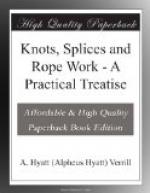[Illustration: FIG. 76.—Seized shortening.]
[Illustration: FIG. 77.—Bow shortening.]
[Illustration: FIG. 78.—Sheepshank.]
[Illustration: FIG. 79.—Another sheepshank.]
[Illustration: FIG. 80.—Sheepshank with ends seized.]
[Illustration: FIG. 81.—Sheepshank for free-ended rope.]
[Illustration: FIG. 82.—Sheepshank for free-ended rope.]
[Illustration: FIG. 83.—Sheepshank with toggle.]
Grommets are round, endless rings of rope useful in a myriad ways aboard ship as well as ashore. They are often used as handles for chests, for rings with which to play quoits, to lengthen rope, and in many similar ways. The grommet is formed of a single strand of rope five times as long as the circumference of the grommet when complete. Take the strand and lay one end across the other at the size of loop required and with the long end follow the grooves or “lay” of the strand until back to where you started (Fig. 84), thus forming a two-stranded ring. Then continue twisting the free end between the turns already made until the three-strand ring is complete (Fig. 85). Now finish and secure the ends by making overhand knots, pass the ends underneath the nearest strands and trim ends off close (Fig. 86). If care is taken and you remember to keep a strong twist on the strand while “laying up” the grommet, the finished ring will be as firm and smooth and endless as the original rope.
[Illustration: FIGS. 84, 85, and 86.—Grommet complete and making.]
A “Sevagee” or “Selvagee” strap is another kind of ring (Fig. 87). This is made by passing a number of strands or yarns around pins or nails set in a board (Fig. 88), and binding the whole together with a seizing of yarn or marline (Fig. 89). These are strong, durable straps much used for blocks aboard ship, for handles to boxes and chests, and in many similar ways. A “Flemish Eye” (Fig. 90) is an eye made in a manner much like that employed in forming the selvagee strap. Take a spar or piece of wood the size of the intended eye A. Around this wood lay a number of pieces of yarn or marline, B, B, B, and fasten them by tying with twine as at C. Whip the piece of rope in which eye is to be formed and unravel and open out the strands as at D. Lap the yarns over the wood and the stops B, and fasten together by overhand knots E, worm the free ends under and over and then bring up the ends of the stops B and tie around the strands of eye as shown. The eye may be finished neatly by whipping all around with yarn or marline, and will then appear as in Fig. 90 B. An “Artificial Eye” (Fig. 91) is still another form of eye which will be found useful and in some ways easier and quicker to make than a spliced eye, besides being stronger.
[Illustration: FIG. 87.—Selvagee strap.]
[Illustration: FIG. 88.—Selvagee board.]




